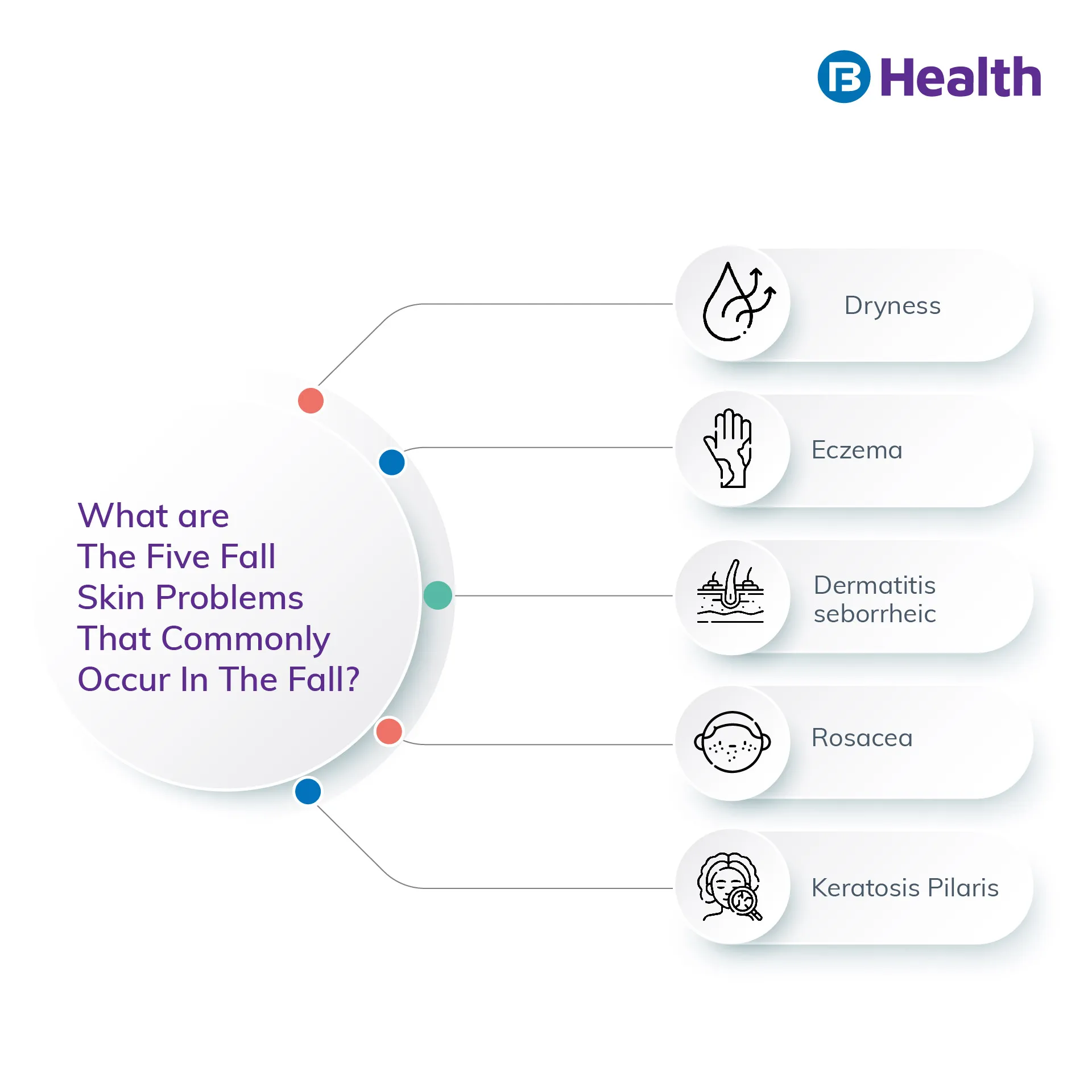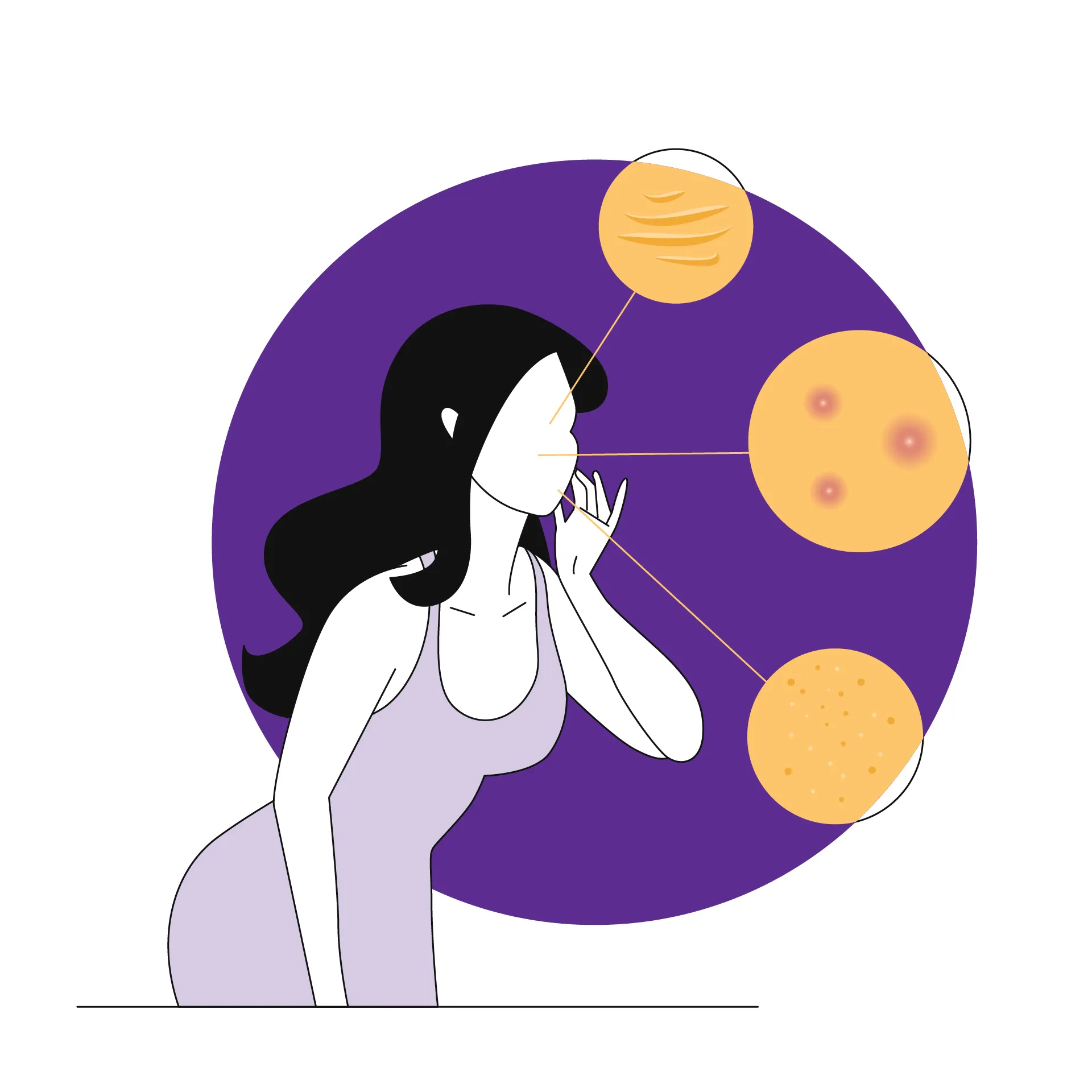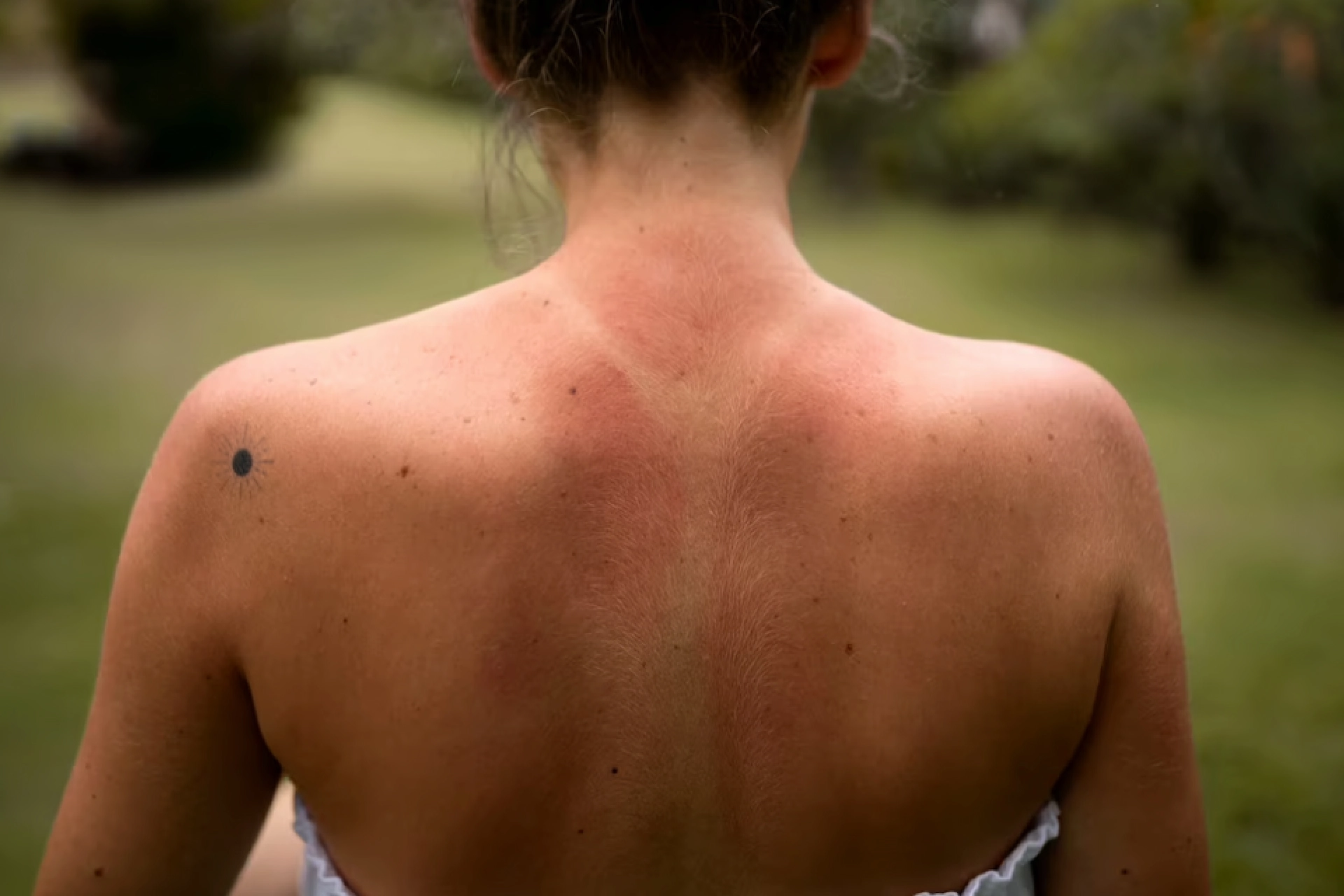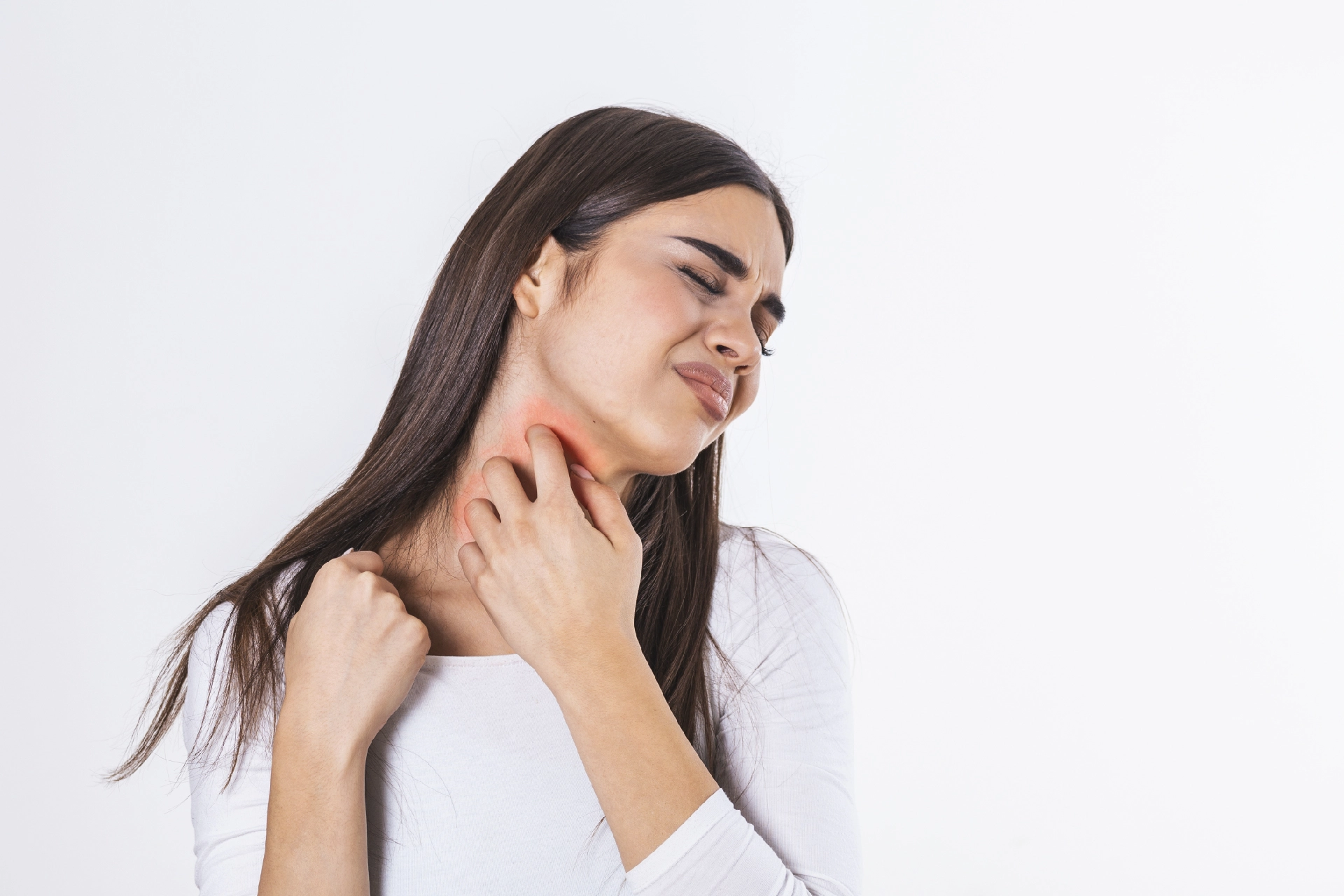Dermatologist | 8 min read
Five Fall Season Skin Problems to Look Out for This Season
Medically reviewed by
Table of Content
Synopsis
The colder, drier air makes the skin retain less moisture leading to fall skin problems. The common skin diseases in autumn caused by a lack of moisture like skin dryness, dull and sallow skin tone, sun spots, skin peeling, irritation. Here are a few things in this blog that everyone should to know this fall season to protect their skin.
Key Takeaways
- Change in the season can bring several skin problems and even change your skin colour
- Fall skin problems can easily be prevented or remedied with the help of simple measures
- The changing fall season can even affect your nails and feet
Fall is here, and so are fall skin problems. When you think of the fall season, the first thing that immediately comes to mind is the changing colours of the leaves, which make the surroundings even more attractive. However, it is not just the leaves that change colour in the fall. Your skin also changes colour. The colder, drier air makes the skin retain less moisture causing fall skin problems. Skin dryness, dull and sallow skin tone, sun spots, peeling, irritation, and the flare-up of some chronic illnesses are all caused by a lack of moisture. But none of this should keep you from enjoying the best season of the year, should it?
Fortunately, fall skin problems can be avoided and treated by implementing simple skin care measures. The skin requires more nourishment and protection throughout the fall season. As a result, whether it's fall, winter, or summer, three things everyone should do to protect their skin include:
- Drink plenty of water to stay hydrated
- Apply moisturizer before going outside
- Wear sunscreen with an SPF of at least 15
The simple tips mentioned above can help you combat fall skin problems and make your fall more pleasurable for you and your skin. But first, let's look at the most frequent fall skin problems.
Common Fall Skin Problems
If we are not prepared for changes in weather and temperature, they may wreak havoc on our skin without even knowing. The best thing we can do to assist our skin transition easily this fall season is to ensure that our skincare regimen transitions, giving our skin everything it requires to withstand cooler and dryer weather conditions. Here are five fall skin problems and tips to overcome them:
1. Dryness
When the weather becomes chilly, the skin can become dry and flaky. And turning on a room heater at your workplace or bedroom just exacerbates the situation.
2. Eczema
Those suffering from this fall skin problem know that chilly temperatures can aggravate it. Yellow or white colour scaly patches that flake off are a classic symptom of this condition, and the afflicted regions may be red, itchy, greasy, or oily. Furthermore, individuals with eczema may experience hair loss on their skin in the rash region.

3. Dermatitis seborrheic
Dandruff is a common term for this ailment. Dead skin flakes can cling to your scalp, cheeks, and even your brows, which is unsightly.
4. Rosacea
One of the typical fall skin problems triggered by the transition to fall is rosacea, which tends to flare up when temperatures change from warm to cool, which can happen throughout the fall. This chronic skin condition fades and relapses in cycles. Spicy meals, too much sunshine, stress, alcoholic beverages, and the gut bacterium Helicobacter pylori can all cause relapses. Face flushing and redness, red and raised pimples, skin dryness, and skin sensitivity are all common symptoms of rosacea.
5. Keratosis Pilaris
Keratosis Pilaris is one of the many fall skin problems faced by people. This condition might cause raised skin patches on your arms; they shouldn't hurt, but they look unappealing. This problem frequently worsens when you start wearing more layers of clothing as the weather gets chilly. These types of fall skin problems often are smaller than 2 cm in diameter or approximately the size of a pencil eraser. It causes a thick, scaly, or crusty skin patch. Keratosis is most commonly found in sun-exposed areas of the body (hands, arms, face, scalp, and neck). It is commonly pink, although it can also have a brown, tan, or grey base.
Additional read: Keratosis Pilaris: Causes and SymptomsAvoiding Fall Skin Problems: Effective Skincare Tips
While many look forward to a cool, refreshing fall after a long, scorching summer, it's vital to remember that your requires extra skin care as the season changes. Changing your beauty and skincare routines regularly, depending on the weather, and staying in constant contact with your dermatologist may help you maintain perfect skin and avoid these fall skin problems. So, for the time being, here are some recommendations to make this autumn better for you and your skin.
Face
Even if the sun sets earlier, it is still critical to use sunscreen in the fall. And regardless of skin type, moisturizing is more vital than ever. Even oily skin needs a moisturizer, as this season can bring on flare-ups, which is one of the most common fall skin problems.
Body
One of the most important things we can do to improve the quality and feel of our skin is to apply moisturizer while the body is somewhat damp after washing. Apply body oil or lotion to the entire body, particularly to rough regions such as the elbows, knees, and feet. Moisturizers containing alpha hydroxy acids help exfoliate the skin's outermost layer [1]. Since sweating is a natural means of eliminating pollutants, exercise is also an excellent way to moisturize your skin and avoid fall skin problems.
Some people may develop a flare-up of illnesses such as psoriasis or atopic dermatitis in the fall. Psoriasis is a chronic immune system illness that manifests on the skin as thick, red, scaly patches. Several over-the-counter and prescription psoriasis therapies are available for these fall skin diseases.
Atopic dermatitis, often known as eczema, causes itching, which can cause swelling, redness, 'weeping' of clear fluid, crusting, cracking, and scaling of the skin. A dermatologist should treat eczema to ensure an accurate diagnosis and suitable therapy, including medication and lifestyle modifications. In addition, they may be able to identify a specific allergy to help alleviate eczema and other fall skin problems.
Scalp
Fall can bring on flare-ups of seborrhea or dandruff. These chronic inflammatory skin diseases in autumn are widespread and affect many people but are more frequent in males than females. It can be treated with specific shampoos, improved stress management strategies, proper eating, and topical steroids. A dermatologist can administer further treatments if seborrhea does not improve or worsens.
Additional Read: Anthrax Disease
Arms
Sun damage can cause hyperpigmented patches on one of the most exposed body parts, such as the face, arms, and shoulders. These flat, usually grey, brown, or black blemishes are often known as age spots or liver spots. These are usually harmless and do not require treatment. However, because they might be mistaken for malignant growths, any new markings should be examined by a doctor for skin tag removal. Age spots can occasionally be reduced with skin bleaching [2] or entirely removed using laser treatment for aesthetic reasons. However, avoiding direct contact with the sun's UV rays as much as possible and always wearing sunscreen to avoid age spots may be the simplest strategy to avoid them.
Keratosis pilaris, which causes rough patches and tiny, acne-like lumps on the arms and thighs, is amongst common fall skin problems that can flare up. Indeed, keratosis pilaris may improve over the summer, only to worsen when the weather changes. This illness is not life-threatening, but it is tough to cure. However, prescription drugs and self-care practices like keeping your skin moist can help enhance your skin's look. Keratosis pilaris can develop at any age; however, it is more frequent in children but often improves on its own.
Nails
Yes, you read it right, nails. Our fingernails and toenails are made up of skin cells. The portion we call the nail is generally known as the 'nail plate.' The nail plate is formed mainly of keratin, a rigid material. In the fall, it is usual for nails to begin breaking or peeling. The solution is to avoid intense washes and apply moisturizer more frequently.
Feet
Dry, cracked heels caused by wearing open-backed shoes throughout the summer are among the common types of fall skin diseases of the foot towards the conclusion of the season. Cracked heel issues can range from minor, with dry or flaky skin, to severe and painful, with hard skin and deep cracks that bleed and make walking difficult. Cracked heels can be cared for by sloughing away dead skin with a foot scrub and pumice stone and hydrating with petroleum jelly, a highly concentrated emollient base, or a healing, natural oil, such as urea or alpha hydroxy acid, olive or sesame. In difficult situations, online doctor consultations and prescription creams may be necessary. Scrubbing is not recommended if one has certain skin diseases, such as psoriasis.
Additional Read: Boost Your Skin Health with UbtanWhen to Consult a Dermatologist?
All problems that irritate, clog or harm your skin, as well as skin cancer, come under the umbrella of fall season skin problems. You might be born with a skin issue or develop one later in your life. Many skin illnesses result in itching, dry skin, or rashes. Good skincare, medications, and minor lifestyle modifications can help you manage these symptoms and avoid these common fall skin problems. Treatment, on the other hand, can lessen symptoms and even hold them at bay for months. Unfortunately, many skin disorders never totally disappear. Furthermore, do not take the change in skin colour, pigmentation, or patches lightly. The majority of skin malignancies are treatable if caught and treated early.
While these fall skin problems might be annoying, they are typically not dangerous. Most vanish after a few days or weeks. However, contact us if a rash or other skin condition persists or worsens. You can consult doctors if you have any questions regarding these fall skin problems to improve your skincare routine. Bajaj Finserv Health is dedicated to assisting our clients in looking and feeling their best.
References
- https://www.indiatoday.in/lifestyle/wellness/story/6-common-skin-problems-sunburn-acne-unhealthy-you-suffer-hot-summer-heat-weather-humid-tips-to-deal-with-them-322690-2016-05-10
- https://www.everydayhealth.com/beauty-pictures/7-surprising-causes-of-dry-skin.aspx
Disclaimer
Please note that this article is solely meant for informational purposes and Bajaj Finserv Health Limited (“BFHL”) does not shoulder any responsibility of the views/advice/information expressed/given by the writer/reviewer/originator. This article should not be considered as a substitute for any medical advice, diagnosis or treatment. Always consult with your trusted physician/qualified healthcare professional to evaluate your medical condition. The above article has been reviewed by a qualified doctor and BFHL is not responsible for any damages for any information or services provided by any third party.





